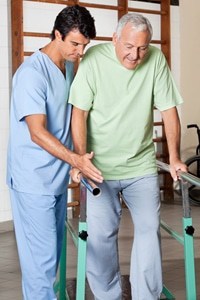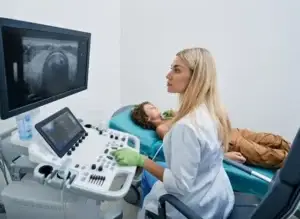 Physical therapy can do more than help those who are are suffering from ill-timed workout injuries – it can also help cancer patients combat the pain that comes with fighting the terrible disease. From chemotherapy to mastectomies and reconstructive surgeries, the steps that need to be taken to fight and overcome cancer can bring on a whole host of painful side effects. In fact, nearly 25 percent of cancer survivors in the U.S. report having a poor mental and physical quality of life1, according to the 2010 National Health Interview Survey. “I could not stand up straight, I could not hold my shoulders back, I could not walk,” Carmen Baugh, whose radiation treatment for cancer left her feeling frail for 30 years, told New York ABC affiliate WABC.2 Baugh, like so many other cancer survivors, turned to physical therapists and their assistants for help. After just five months of rehabilitation, Baugh said she could see a drastic improvement and can now walk three miles without being in constant pain. For many cancer patients, physical therapy can be the difference between simply surviving and being able to return to a normal, independent life. “The traditional model, I think is very important, but there are things we can do to complement it to make patients feel better,” Susana Soth, a registered nurse and breast cancer survivor, told The Spokesman-Review.3 While the pain associated with different types of cancers vary – from needing to rebuild the strength in the arms, to combating back pain, to improving overall stamina – physical therapists and their assistants have clear roles to play in improving quality of life. “I am able to get a lot of relief and a lot of times patients don’t need to have further intervention,” Dr. Julie Silver, an assistant professor at Harvard Medical School who started a program to train physical therapists, told NPR. “They don’t want to be on the narcotics for the pain management. They would rather come here.”4 1 Weaver, KE et. al., Wake Forest School of Medicine, ‘Mental and physical health-related quality of life among U.S. cancer survivors: population estimates from the 2010 National Health Interview Survey, Oct. 30, 2012 – http://www.ncbi.nlm.nih.gov/pubmed/23112268 2 Parikh, Dr. Sapna, New York ABC affiliate WABC, ‘Physical therapy helps patients after Cancer treatments,’ Feb. 12, 2013 – Rogers, Adrian, The Spokesman-Review, ‘Physical therapy helps cancer patients bounce back,’ May 21, 2013 – http://www.spokesman.com/stories/2013/may/21/recovery-in-motion/ 4 Gotbaum, Rachel, NPR, ‘Cancer Rehab Begins to Bridge a Gap To Reach Patients,’ Feb. 18, 2013 – http://www.npr.org/blogs/health/2013/02/18/172099043/cancer-rehab-begins-to-bridge-a-gap-to-reach-patients
Physical therapy can do more than help those who are are suffering from ill-timed workout injuries – it can also help cancer patients combat the pain that comes with fighting the terrible disease. From chemotherapy to mastectomies and reconstructive surgeries, the steps that need to be taken to fight and overcome cancer can bring on a whole host of painful side effects. In fact, nearly 25 percent of cancer survivors in the U.S. report having a poor mental and physical quality of life1, according to the 2010 National Health Interview Survey. “I could not stand up straight, I could not hold my shoulders back, I could not walk,” Carmen Baugh, whose radiation treatment for cancer left her feeling frail for 30 years, told New York ABC affiliate WABC.2 Baugh, like so many other cancer survivors, turned to physical therapists and their assistants for help. After just five months of rehabilitation, Baugh said she could see a drastic improvement and can now walk three miles without being in constant pain. For many cancer patients, physical therapy can be the difference between simply surviving and being able to return to a normal, independent life. “The traditional model, I think is very important, but there are things we can do to complement it to make patients feel better,” Susana Soth, a registered nurse and breast cancer survivor, told The Spokesman-Review.3 While the pain associated with different types of cancers vary – from needing to rebuild the strength in the arms, to combating back pain, to improving overall stamina – physical therapists and their assistants have clear roles to play in improving quality of life. “I am able to get a lot of relief and a lot of times patients don’t need to have further intervention,” Dr. Julie Silver, an assistant professor at Harvard Medical School who started a program to train physical therapists, told NPR. “They don’t want to be on the narcotics for the pain management. They would rather come here.”4 1 Weaver, KE et. al., Wake Forest School of Medicine, ‘Mental and physical health-related quality of life among U.S. cancer survivors: population estimates from the 2010 National Health Interview Survey, Oct. 30, 2012 – http://www.ncbi.nlm.nih.gov/pubmed/23112268 2 Parikh, Dr. Sapna, New York ABC affiliate WABC, ‘Physical therapy helps patients after Cancer treatments,’ Feb. 12, 2013 – Rogers, Adrian, The Spokesman-Review, ‘Physical therapy helps cancer patients bounce back,’ May 21, 2013 – http://www.spokesman.com/stories/2013/may/21/recovery-in-motion/ 4 Gotbaum, Rachel, NPR, ‘Cancer Rehab Begins to Bridge a Gap To Reach Patients,’ Feb. 18, 2013 – http://www.npr.org/blogs/health/2013/02/18/172099043/cancer-rehab-begins-to-bridge-a-gap-to-reach-patients



